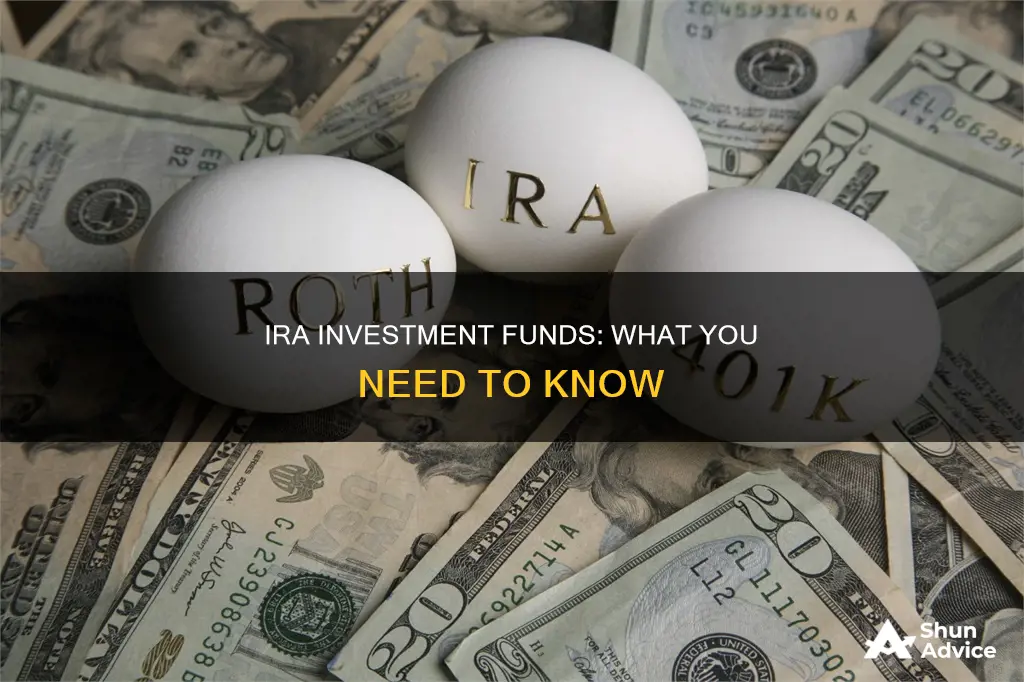
An IRA, or Individual Retirement Account, is a tax-advantaged savings account that allows your money to grow without being taxed. There are two main types of IRAs: traditional IRAs and Roth IRAs. The main difference between the two is when you pay taxes on the money in the account. With a traditional IRA, you pay taxes when you withdraw the money, typically during retirement, whereas with a Roth IRA, you pay taxes on the money when you deposit it into the account, and then all future withdrawals are tax-free. When it comes to investing your IRA, you have a variety of options, including stocks, bonds, mutual funds, exchange-traded funds (ETFs), and more. The best investments for your IRA will depend on your risk tolerance, time horizon, and investment goals.
| Characteristics | Values |
|---|---|
| Type of account | Individual retirement account (IRA) |
| Tax advantages | Tax-free growth and withdrawals |
| Eligibility | Income thresholds apply |
| Investment options | Stocks, bonds, mutual funds, exchange-traded funds (ETFs), target-date funds, robo-advisors, etc. |
| Risk considerations | Age, time horizon, and tolerance for risk are key factors |
| Diversification | Recommended to reduce risk and enhance returns |
| Professional advice | Available from financial advisors and investment professionals |
| Costs | Consider fees, commissions, and expense ratios |

Stocks and bonds
When it comes to IRAs, the mix of stocks and bonds in your portfolio depends on two primary factors: your risk tolerance and your time horizon, or how long you plan to invest for. If you're further from retirement, you may be able to tolerate more volatility in your portfolio and hold more stocks. As you get closer to retirement, you may want to reduce your risk exposure and increase your allocation of bonds.
There are different types of stocks and bonds to consider for your IRA. For stocks, you can choose between individual stocks or stock funds, such as index funds or exchange-traded funds (ETFs). Index funds and ETFs offer a more diversified approach by providing exposure to a basket of investments rather than individual companies. For bonds, you can choose between individual bonds or bond funds, including bond mutual funds and bond ETFs.
When selecting stocks and bonds for your IRA, it's important to understand the tax implications. IRAs offer tax advantages, allowing your investments to grow tax-free or tax-deferred, depending on the type of IRA you choose. In a Roth IRA, for example, your contributions are made with after-tax dollars, and your investments grow tax-free. Withdrawing from a Roth IRA is also tax-free, provided you meet certain conditions.
To optimise your IRA, consider an "asset location" strategy, which involves choosing the right types of accounts for your investments to minimise taxes. For example, municipal bonds, which offer tax-exempt interest, may be better held in a regular account rather than an IRA. On the other hand, high-yield bonds, which offer higher interest rates, can be a good option for a Roth IRA, as the interest income will never be taxed.
Ultimately, the decision to invest in stocks, bonds, or a combination of both in your IRA depends on your financial goals, risk tolerance, and investment horizon. It's always a good idea to do your research and consult with a financial professional before making any investment decisions.
How to Choose a Qualified Opportunity Fund for Investing
You may want to see also

Asset allocation
When allocating assets in an IRA, it's important to consider the level of risk you are comfortable with. Stocks, also known as equities, typically offer the highest returns over time but come with higher risk. On the other hand, bonds and fixed-income investments are relatively safer and help balance the risk in your portfolio. Your age plays a crucial factor in determining your asset allocation. Generally, younger investors can allocate more funds towards stocks, while older investors approaching retirement may want to shift towards more conservative investments like bonds.
There are various investment vehicles available for IRAs, including individual stocks and bonds, mutual funds, and exchange-traded funds (ETFs). Mutual funds and ETFs offer diversification by allowing you to invest in a basket of securities rather than individual stocks. Index funds, a type of mutual fund or ETF, aim to replicate the performance of a specific stock market index, such as the S&P 500. They provide broad market exposure and are typically cost-efficient.
Additionally, target-date funds are a popular choice for IRA investors as they automatically adjust their asset allocation based on your selected retirement timeline, becoming more conservative as you approach retirement. These funds are designed to simplify the investment process by providing a diversified portfolio in a single fund.
It's important to note that there is no one-size-fits-all approach to asset allocation in an IRA. Your specific circumstances, risk tolerance, and financial goals will influence your investment decisions. Consulting with a financial advisor can help you determine an appropriate asset allocation strategy for your IRA.
Setting Up an Investment Fund: Hong Kong Guide
You may want to see also

Risk tolerance
Your risk tolerance will depend on several factors, including your time horizon (how long you plan to invest for), your knowledge of the markets, and your financial goals. For example, if you are investing for the long term, you may be able to take on more risk as you can afford to ride out any short-term losses. On the other hand, if you are investing for a short-term goal, such as saving for a house deposit, you will likely have a lower risk tolerance.
There are generally three types of risk tolerance: conservative, moderate, and aggressive. A conservative risk tolerance focuses on capital preservation and avoiding downside risk, which means accepting lower returns. Moderate risk tolerance strikes a balance between growth and stability, often through a mix of stocks and bonds. Aggressive risk tolerance involves investing primarily in riskier assets like stocks and real estate, with a focus on capital appreciation and higher potential returns.
When determining your risk tolerance, consider your investment objectives, time horizon, and how you would react to a significant loss. It's important to be honest about your level of investment experience and knowledge as well.
Your risk tolerance will influence the types of investments you choose for your IRA. For example, if you have a higher risk tolerance, you may invest in stocks, equity funds, or exchange-traded funds (ETFs). On the other hand, if you have a lower risk tolerance, you may prefer bonds, bond funds, income funds, or guaranteed investments like certificates of deposit (CDs).
Fidelity Proof of Funds: Accessing Investment Account Verification
You may want to see also

Mutual funds
A mutual fund is a type of investment fund that pools money from multiple investors to invest in a diversified portfolio of stocks, bonds, or other securities. Mutual funds are managed by professional portfolio managers or investment teams who make investment decisions on behalf of the investors. They are suitable for investors with various risk tolerances and investment objectives due to their diversification and professional management.
When considering mutual funds for an IRA, it is important to keep in mind the time horizon and risk tolerance. The further away the investor is from retirement, the more volatility they can typically tolerate, and thus they may hold more stocks in their portfolio. As retirement approaches, investors may want to shift towards more conservative investments to preserve their savings.
There are various types of mutual funds, including equity funds, fixed-income funds, money market funds, and hybrid funds. Equity funds invest in stocks, offering the potential for higher returns but also come with higher risks. Fixed-income funds focus on bonds and provide a more stable income stream with lower risk. Money market funds invest in short-term debt instruments and cash equivalents, offering liquidity and low risk. Hybrid funds combine multiple types of funds to offer a balanced approach.
When investing in mutual funds through an IRA, it is important to consider the tax implications. Traditional IRAs offer tax benefits on contributions, while Roth IRAs offer tax-free growth and withdrawals. The choice between the two will depend on the investor's tax situation and goals.
Some highly-rated mutual funds for IRAs include the Vanguard Dividend Growth Fund (VDIGX), Dodge & Cox International Stock Fund (DODFX), and FPA Crescent Fund (FPACX). These funds offer diversified portfolios of stocks, bonds, and other securities, providing investors with exposure to different asset classes.
In summary, mutual funds can be a great option for investors looking for professional management and diversification in their IRA. It is important to consider the investor's time horizon, risk tolerance, and tax situation when choosing mutual funds for an IRA.
Emergency Fund or Investing: Where Should Your Money Go?
You may want to see also

Tax efficiency
An IRA, or Individual Retirement Account, is a tax-advantaged investment account. There are two types of IRAs: traditional IRAs and Roth IRAs. Both types of IRAs have annual contribution limits and penalties for non-qualified withdrawals.
The main difference between the two types of IRAs is when you pay taxes on the money in the account. With a traditional IRA, you pay taxes when you withdraw the money during retirement, whereas with a Roth IRA, you pay taxes upfront on contributions, and withdrawals during retirement are tax-free.
IRAs are tax-efficient because they allow investors to minimise their tax burden and maximise their bottom line. Investors should consider their tax efficiency when choosing which investments to hold in their IRA. For example, investors should place tax-inefficient funds, such as bond funds, into tax-advantaged accounts like IRAs, and place tax-efficient funds, such as stock funds, into taxable accounts.
Additionally, investors should consider their asset allocation, or how their money is divided among different types of investments, and their tolerance for risk when choosing investments for their IRA. Mutual funds and exchange-traded funds (ETFs) are popular investment options for IRAs as they offer better diversification and, over the long term, better results.
A Guide to Investing in Mutual Funds via Zerodha
You may want to see also
Frequently asked questions
An IRA (Individual Retirement Account) is a tax-advantaged savings account that allows your money to grow without being taxed, so you have more money for retirement.
The best investments for an IRA are those with strong long-term growth potential and little chance of decline. Dividend stock funds, Nasdaq-100 index funds, and value stock funds are all popular options.
You should consider your risk tolerance and how long you have until retirement. Generally, the younger you are, the more risk you can take on.
An IRA allows you to build a nest egg that the government will never be able to tax. You can also choose from a wide range of investment options, including stocks, bonds, mutual funds, and ETFs.
Yes, there are income limits for contributing to an IRA. For example, for the 2024 tax year, single filers with an income above $146,000 could not contribute to a Roth IRA.
IRA stands for Individual Retirement Account.







